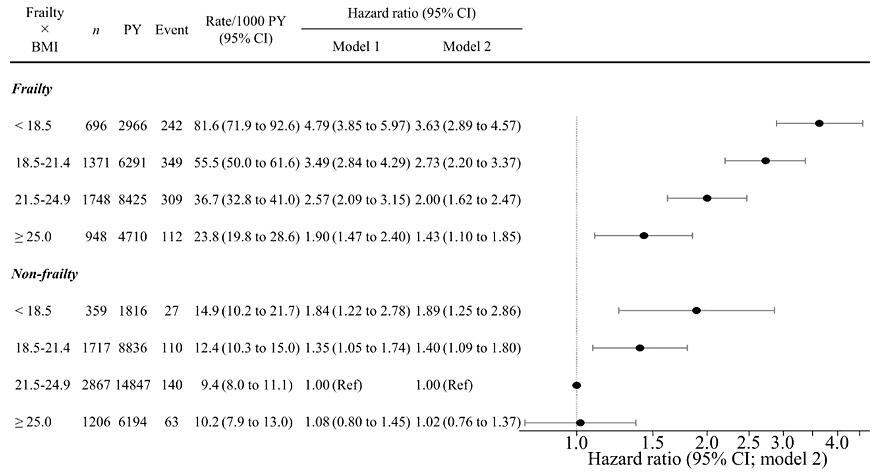Assistant Professor Daiki Watanabe and Professor Motohiko Miyachi of the Faculty of Sport Sciences at Waseda University reported, for the first in the world, that the optimal BMI for the lowest mortality risk differs between older adults with and without frailty, based on the results of their examination of the dose-response relationship between BMI and mortality among 10,912 Japanese older adults aged 65 years and older.
The results of this joint research with Researcher Tsukasa Yoshida and Section Head Yosuke Yamada of the National Institutes of Biomedical Innovation, Health and Nutrition, Associate Professor Yuya Watanabe of Biwako Seikei Sport College, and Visiting Researcher Misaka Kimura of Kyoto University of Advanced Science were published online on January 4, ahead of print in the international journal Clinical Nutrition.

Watanabe et. al. 10.1016/j.clnu.2024.01.002. CC by 4.0
Frailty is a condition of reduced physical and mental reserve capacities (physical function and mental and social health), which is a state between being healthy and requiring nursing care. Because the prevalence of frailty increases with age, it is becoming a health issue in countries with aging societies, including Japan.
BMI is an internationally recognized index used to classify underweight and obesity. This index is calculated by dividing a person's weight (in kilograms) by the square of their height (in meters). BMI values of < 18.5 kg/m2, 18.5 to < 25 kg/m2, and ≥ 25.0 kg/m2 are classified as underweight, normal weight, and obese, respectively.
As older adults are presumed to have a lower mortality risk caused by higher BMI values than middle-aged adults, evaluating optimal physical status in older adults is important for their longevity. However, the effects of frailty on the association between BMI and mortality in Japanese older adults had not been investigated.
The current study used data from 10,912 participants enrolled in the Kyoto-Kameoka Study, a prospective cohort study that aims to promote and investigate nursing care prevention in Kameoka City, Kyoto since 2011. After assessing BMI, the researchers followed up the participants for a median of 5.3 years to assess mortality. A total of 352 participants died during the follow-up. The prevalence of frailty among all participants was 43.7%.
The results showed that, compared with participants with a BMI of 21.5−24.9 kg/m2 (normal), participants with a BMI < 18.5 kg/m2 (underweight) had significantly lower survival rates regardless of frailty status.
Moreover, compared with non-frail participants with a BMI of 21.5−24.9 kg/m2 (normal weight), frail participants with a BMI of ≥ 25.0 kg/m2 (obese) had a higher mortality rate.
In older adults with frailty, a higher BMI was associated with a lower mortality risk, whereas, in older adults without frailty, the mortality risk was lowest for a BMI between 23.0−24.0 kg/m2.
In Japan, the number of older adults with frailty is expected to increase. The results from this study indicate that the target BMI for the lowest mortality risk can be assessed by evaluating frailty, thus providing evidence for improving lifestyle habits in older adults.
Watanabe commented, "Our study demonstrated that frailty could be a factor contributing to the 'obesity paradox,' in which individuals with high BMI (obese individuals) have a lower mortality risk than healthy individuals with normal weight. Our data showing different target BMI ranges for individuals with and without frailty serve as useful evidence for the development of more detailed dietary and nutrition guidance and health policies."
Miyachi added, "Our results showed that being underweight hinders longevity in all older adults regardless of frailty status. However, concluding that being overweight helps us to live long is risky as well. We recommend that everyone maintain a physical status that is neither underweight nor overweight by moving their bodies energetically and eating a well-balanced diet every day."
Journal Information
Publication: Clinical Nutrition
Title: Frailty modifies the association of body mass index with mortality among older adults: Kyoto-Kameoka study
DOI: 10.1016/j.clnu.2024.01.002
This article has been translated by JST with permission from The Science News Ltd. (https://sci-news.co.jp/). Unauthorized reproduction of the article and photographs is prohibited.




